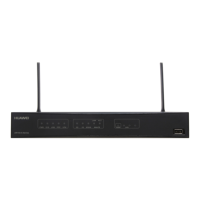Data Preparation
To configure remote flow mirroring, you need the following data.
No. Data
1 Observing server index, IP addresses of mirrored devices, IP address of the mirrored
interface, DSCP field of packets
2 Type and number of the mirrored interface
3 Names of the traffic classifier, traffic behavior, traffic policy, and traffic classification
rules
4.6.2 Configuring the Observing Server
The observing server forwards the packets copied from the mirrored interface to the observing
device through the IP network.
Procedure
Step 1 Run:
system-view
The system view is displayed.
Step 2 Run:
observe-server [ observe-server-index ] destination-ip destination-ip-address
source-ip source-ip-address [ dscp dscp-value ]
The observing server is configured.
NOTE
l destination-ip-address is the IP address of the observing device; source-ip-address is the IP address
of the mirrored interface.
l If the mirrored interface and observing device use private addresses, perform the Configuration Guide
- VPN task before configuring the observing server.
----End
4.6.3 Configuring Complex Traffic Classification
Select proper traffic classification rules and configure complex traffic classification as required.
For the configuration procedure, see Configuring Traffic Classification in the Huawei
AR150&200 Series Enterprise Routers Configuration Guide - QoS.
4.6.4 Configuring the Traffic Behavior
The traffic behavior copies the packets matching the configured traffic classifier to the observing
device.
Huawei AR150&200 Series Enterprise Routers
Configuration Guide - Device Management 4 Mirroring Configuration
Issue 02 (2012-03-30) Huawei Proprietary and Confidential
Copyright © Huawei Technologies Co., Ltd.
71

